HI6008 - Managing Challenges of Small Business Enterprise: ABC Cafe
VerifiedAdded on 2023/06/12
|13
|3749
|81
Literature Review
AI Summary
This literature review examines the challenges faced by small businesses in Australia, focusing on the case of ABC Cafe. It begins by highlighting the significant contribution of small businesses to the Australian economy, particularly in terms of employment. The review identifies both internal challenges, such as financial issues, managerial problems, and high operating costs, and external challenges, including business cycle fluctuations, technological advancements, and intense competition. The paper analyzes how these challenges affect the performance and management of small businesses, particularly within the hotel industry, and references past studies to provide a conceptual and critical analysis of the problem. It also explores the objectives and scope of the project, emphasizing the need for policies that can improve the sector and stimulate economic growth. This paper uses literature review to address the challenges that ABC Cafe is facing in managing the business.
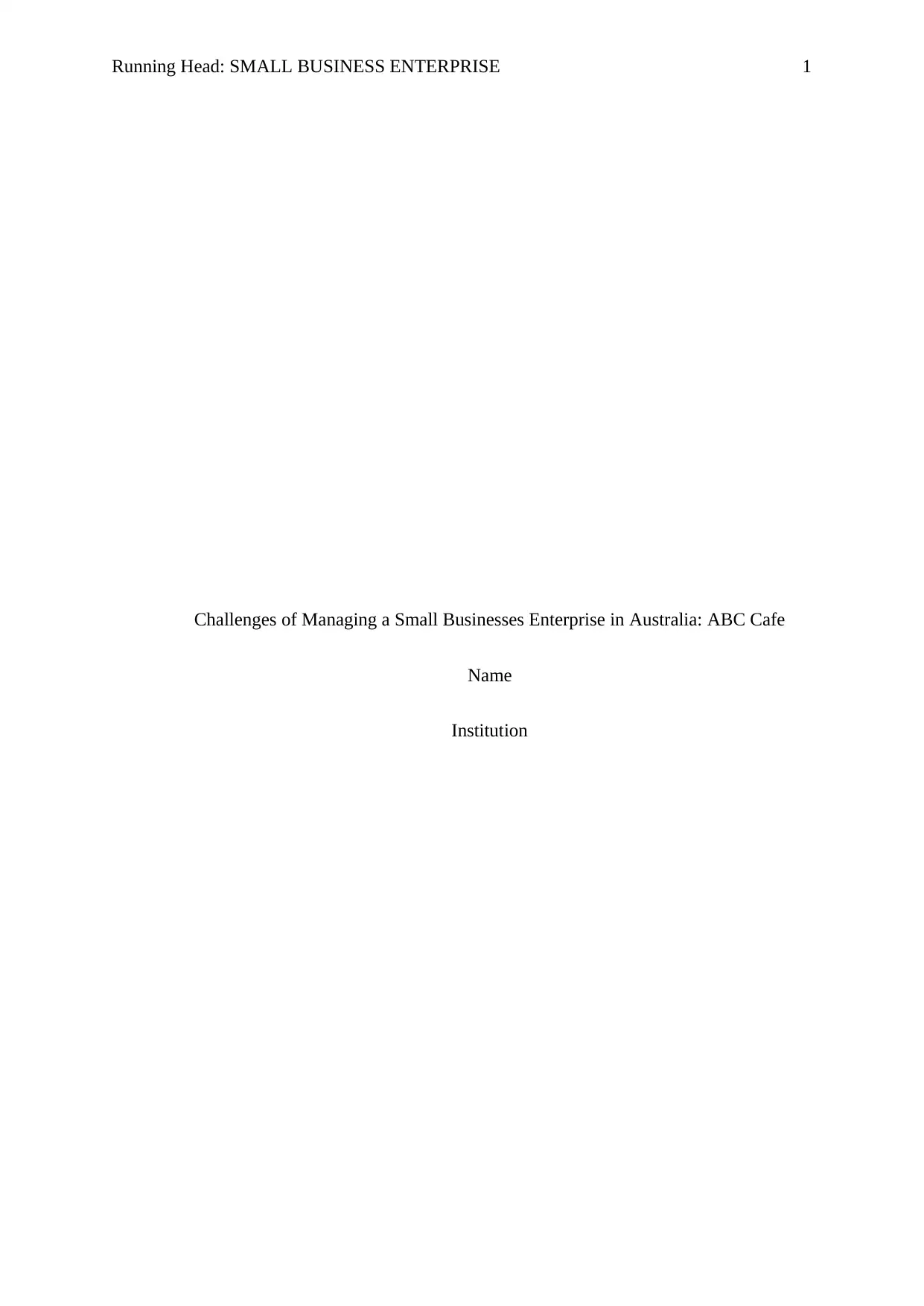
Running Head: SMALL BUSINESS ENTERPRISE 1
Challenges of Managing a Small Businesses Enterprise in Australia: ABC Cafe
Name
Institution
Challenges of Managing a Small Businesses Enterprise in Australia: ABC Cafe
Name
Institution
Paraphrase This Document
Need a fresh take? Get an instant paraphrase of this document with our AI Paraphraser
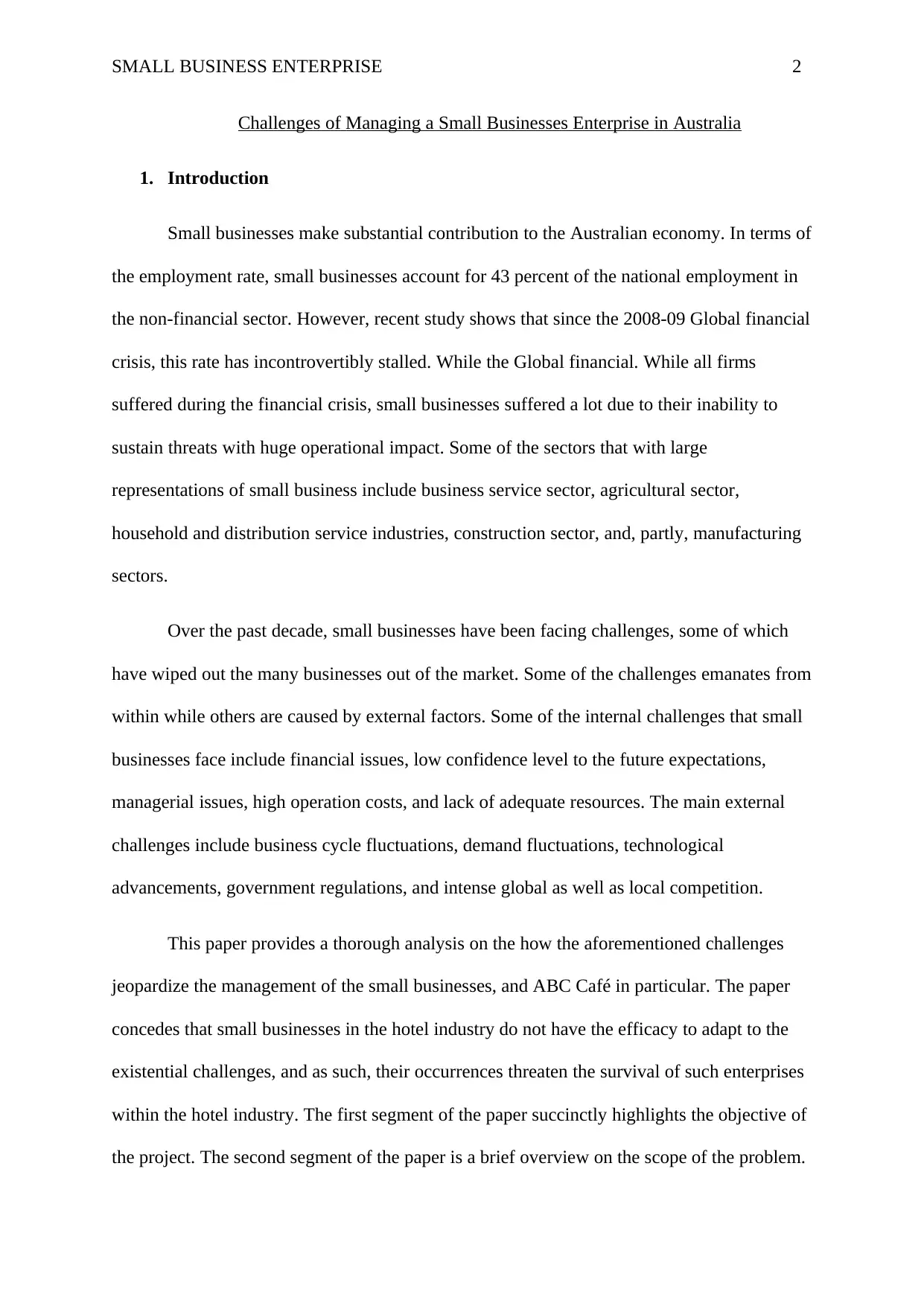
SMALL BUSINESS ENTERPRISE 2
Challenges of Managing a Small Businesses Enterprise in Australia
1. Introduction
Small businesses make substantial contribution to the Australian economy. In terms of
the employment rate, small businesses account for 43 percent of the national employment in
the non-financial sector. However, recent study shows that since the 2008-09 Global financial
crisis, this rate has incontrovertibly stalled. While the Global financial. While all firms
suffered during the financial crisis, small businesses suffered a lot due to their inability to
sustain threats with huge operational impact. Some of the sectors that with large
representations of small business include business service sector, agricultural sector,
household and distribution service industries, construction sector, and, partly, manufacturing
sectors.
Over the past decade, small businesses have been facing challenges, some of which
have wiped out the many businesses out of the market. Some of the challenges emanates from
within while others are caused by external factors. Some of the internal challenges that small
businesses face include financial issues, low confidence level to the future expectations,
managerial issues, high operation costs, and lack of adequate resources. The main external
challenges include business cycle fluctuations, demand fluctuations, technological
advancements, government regulations, and intense global as well as local competition.
This paper provides a thorough analysis on the how the aforementioned challenges
jeopardize the management of the small businesses, and ABC Café in particular. The paper
concedes that small businesses in the hotel industry do not have the efficacy to adapt to the
existential challenges, and as such, their occurrences threaten the survival of such enterprises
within the hotel industry. The first segment of the paper succinctly highlights the objective of
the project. The second segment of the paper is a brief overview on the scope of the problem.
Challenges of Managing a Small Businesses Enterprise in Australia
1. Introduction
Small businesses make substantial contribution to the Australian economy. In terms of
the employment rate, small businesses account for 43 percent of the national employment in
the non-financial sector. However, recent study shows that since the 2008-09 Global financial
crisis, this rate has incontrovertibly stalled. While the Global financial. While all firms
suffered during the financial crisis, small businesses suffered a lot due to their inability to
sustain threats with huge operational impact. Some of the sectors that with large
representations of small business include business service sector, agricultural sector,
household and distribution service industries, construction sector, and, partly, manufacturing
sectors.
Over the past decade, small businesses have been facing challenges, some of which
have wiped out the many businesses out of the market. Some of the challenges emanates from
within while others are caused by external factors. Some of the internal challenges that small
businesses face include financial issues, low confidence level to the future expectations,
managerial issues, high operation costs, and lack of adequate resources. The main external
challenges include business cycle fluctuations, demand fluctuations, technological
advancements, government regulations, and intense global as well as local competition.
This paper provides a thorough analysis on the how the aforementioned challenges
jeopardize the management of the small businesses, and ABC Café in particular. The paper
concedes that small businesses in the hotel industry do not have the efficacy to adapt to the
existential challenges, and as such, their occurrences threaten the survival of such enterprises
within the hotel industry. The first segment of the paper succinctly highlights the objective of
the project. The second segment of the paper is a brief overview on the scope of the problem.
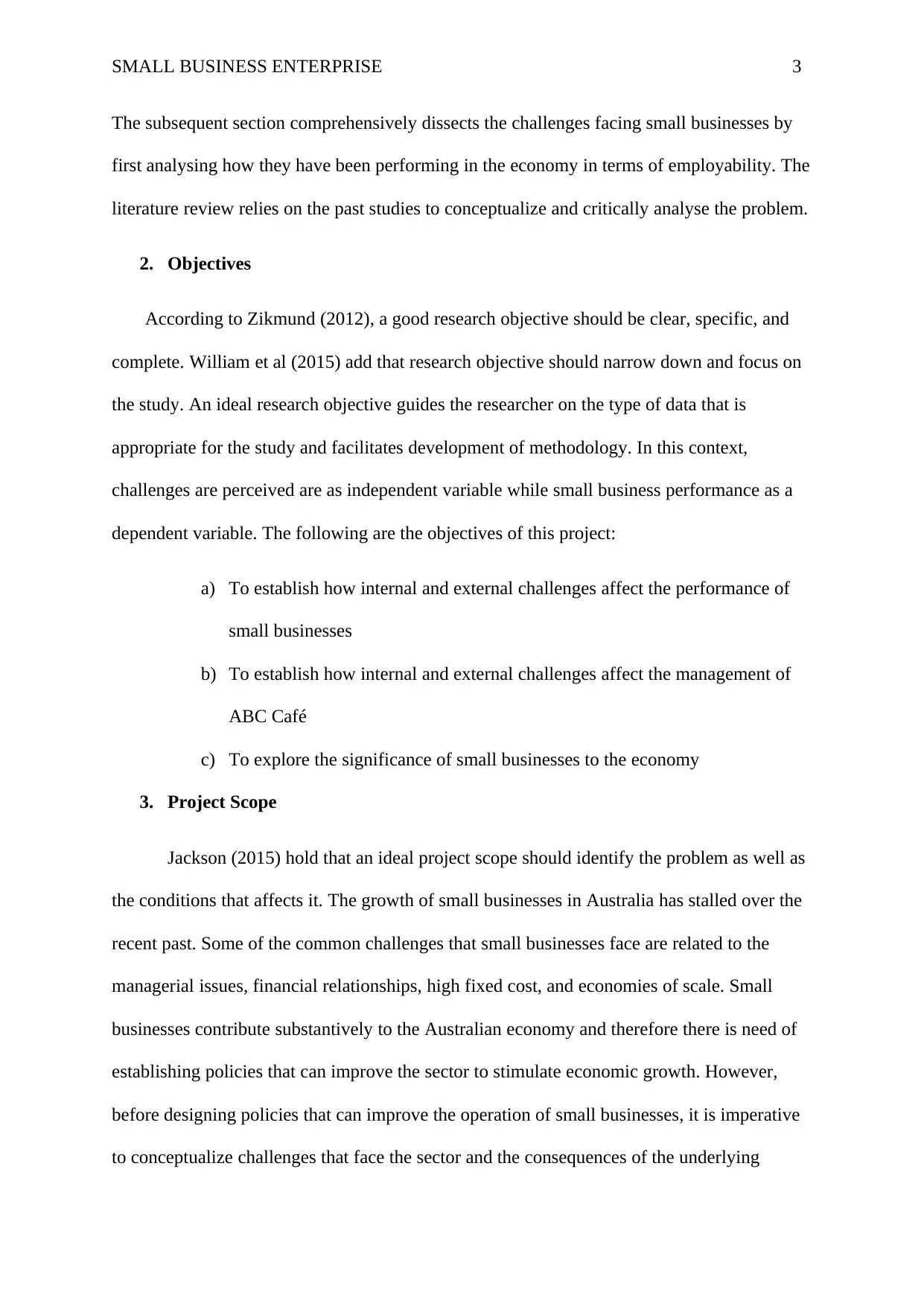
SMALL BUSINESS ENTERPRISE 3
The subsequent section comprehensively dissects the challenges facing small businesses by
first analysing how they have been performing in the economy in terms of employability. The
literature review relies on the past studies to conceptualize and critically analyse the problem.
2. Objectives
According to Zikmund (2012), a good research objective should be clear, specific, and
complete. William et al (2015) add that research objective should narrow down and focus on
the study. An ideal research objective guides the researcher on the type of data that is
appropriate for the study and facilitates development of methodology. In this context,
challenges are perceived are as independent variable while small business performance as a
dependent variable. The following are the objectives of this project:
a) To establish how internal and external challenges affect the performance of
small businesses
b) To establish how internal and external challenges affect the management of
ABC Café
c) To explore the significance of small businesses to the economy
3. Project Scope
Jackson (2015) hold that an ideal project scope should identify the problem as well as
the conditions that affects it. The growth of small businesses in Australia has stalled over the
recent past. Some of the common challenges that small businesses face are related to the
managerial issues, financial relationships, high fixed cost, and economies of scale. Small
businesses contribute substantively to the Australian economy and therefore there is need of
establishing policies that can improve the sector to stimulate economic growth. However,
before designing policies that can improve the operation of small businesses, it is imperative
to conceptualize challenges that face the sector and the consequences of the underlying
The subsequent section comprehensively dissects the challenges facing small businesses by
first analysing how they have been performing in the economy in terms of employability. The
literature review relies on the past studies to conceptualize and critically analyse the problem.
2. Objectives
According to Zikmund (2012), a good research objective should be clear, specific, and
complete. William et al (2015) add that research objective should narrow down and focus on
the study. An ideal research objective guides the researcher on the type of data that is
appropriate for the study and facilitates development of methodology. In this context,
challenges are perceived are as independent variable while small business performance as a
dependent variable. The following are the objectives of this project:
a) To establish how internal and external challenges affect the performance of
small businesses
b) To establish how internal and external challenges affect the management of
ABC Café
c) To explore the significance of small businesses to the economy
3. Project Scope
Jackson (2015) hold that an ideal project scope should identify the problem as well as
the conditions that affects it. The growth of small businesses in Australia has stalled over the
recent past. Some of the common challenges that small businesses face are related to the
managerial issues, financial relationships, high fixed cost, and economies of scale. Small
businesses contribute substantively to the Australian economy and therefore there is need of
establishing policies that can improve the sector to stimulate economic growth. However,
before designing policies that can improve the operation of small businesses, it is imperative
to conceptualize challenges that face the sector and the consequences of the underlying
⊘ This is a preview!⊘
Do you want full access?
Subscribe today to unlock all pages.

Trusted by 1+ million students worldwide
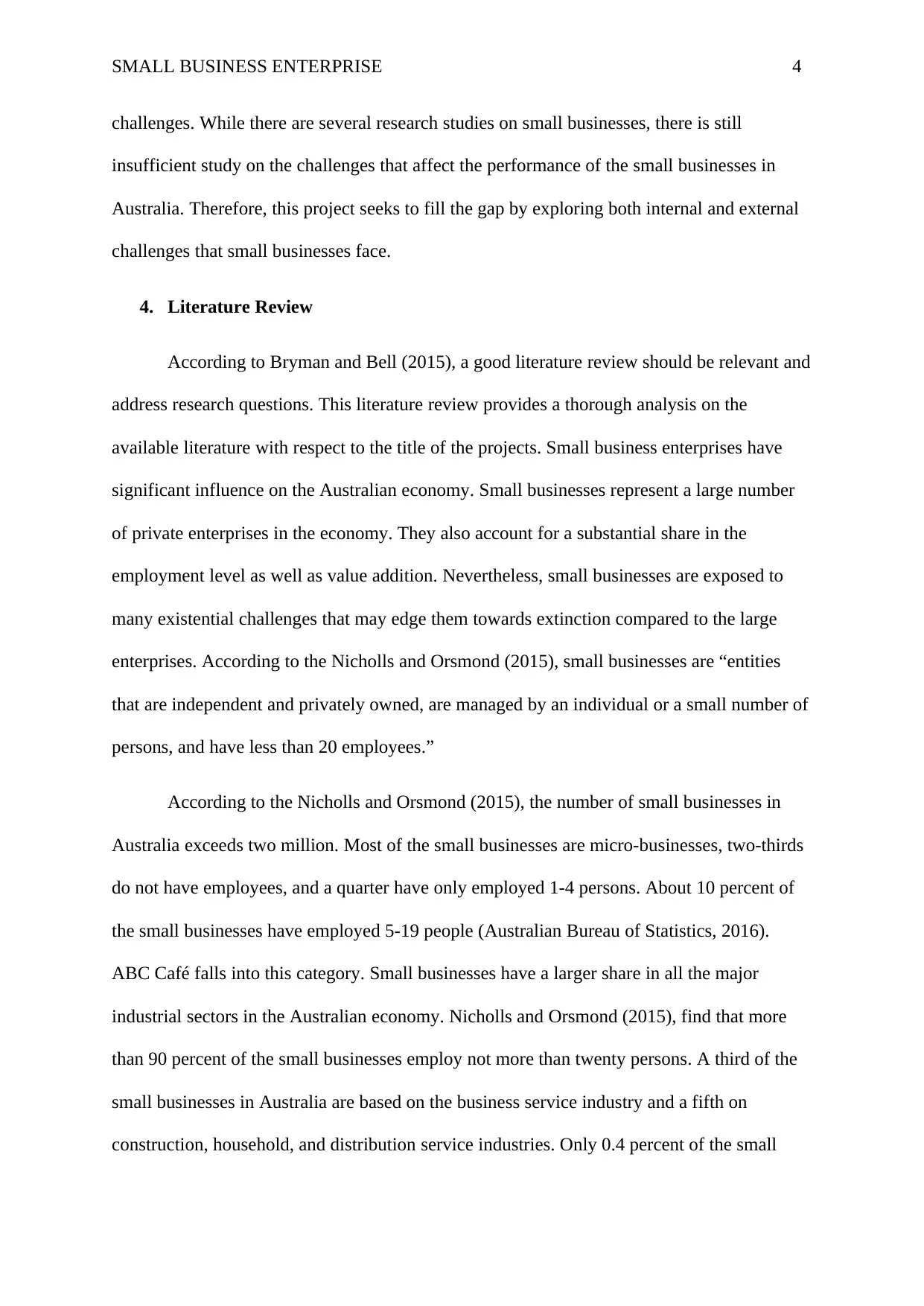
SMALL BUSINESS ENTERPRISE 4
challenges. While there are several research studies on small businesses, there is still
insufficient study on the challenges that affect the performance of the small businesses in
Australia. Therefore, this project seeks to fill the gap by exploring both internal and external
challenges that small businesses face.
4. Literature Review
According to Bryman and Bell (2015), a good literature review should be relevant and
address research questions. This literature review provides a thorough analysis on the
available literature with respect to the title of the projects. Small business enterprises have
significant influence on the Australian economy. Small businesses represent a large number
of private enterprises in the economy. They also account for a substantial share in the
employment level as well as value addition. Nevertheless, small businesses are exposed to
many existential challenges that may edge them towards extinction compared to the large
enterprises. According to the Nicholls and Orsmond (2015), small businesses are “entities
that are independent and privately owned, are managed by an individual or a small number of
persons, and have less than 20 employees.”
According to the Nicholls and Orsmond (2015), the number of small businesses in
Australia exceeds two million. Most of the small businesses are micro-businesses, two-thirds
do not have employees, and a quarter have only employed 1-4 persons. About 10 percent of
the small businesses have employed 5-19 people (Australian Bureau of Statistics, 2016).
ABC Café falls into this category. Small businesses have a larger share in all the major
industrial sectors in the Australian economy. Nicholls and Orsmond (2015), find that more
than 90 percent of the small businesses employ not more than twenty persons. A third of the
small businesses in Australia are based on the business service industry and a fifth on
construction, household, and distribution service industries. Only 0.4 percent of the small
challenges. While there are several research studies on small businesses, there is still
insufficient study on the challenges that affect the performance of the small businesses in
Australia. Therefore, this project seeks to fill the gap by exploring both internal and external
challenges that small businesses face.
4. Literature Review
According to Bryman and Bell (2015), a good literature review should be relevant and
address research questions. This literature review provides a thorough analysis on the
available literature with respect to the title of the projects. Small business enterprises have
significant influence on the Australian economy. Small businesses represent a large number
of private enterprises in the economy. They also account for a substantial share in the
employment level as well as value addition. Nevertheless, small businesses are exposed to
many existential challenges that may edge them towards extinction compared to the large
enterprises. According to the Nicholls and Orsmond (2015), small businesses are “entities
that are independent and privately owned, are managed by an individual or a small number of
persons, and have less than 20 employees.”
According to the Nicholls and Orsmond (2015), the number of small businesses in
Australia exceeds two million. Most of the small businesses are micro-businesses, two-thirds
do not have employees, and a quarter have only employed 1-4 persons. About 10 percent of
the small businesses have employed 5-19 people (Australian Bureau of Statistics, 2016).
ABC Café falls into this category. Small businesses have a larger share in all the major
industrial sectors in the Australian economy. Nicholls and Orsmond (2015), find that more
than 90 percent of the small businesses employ not more than twenty persons. A third of the
small businesses in Australia are based on the business service industry and a fifth on
construction, household, and distribution service industries. Only 0.4 percent of the small
Paraphrase This Document
Need a fresh take? Get an instant paraphrase of this document with our AI Paraphraser
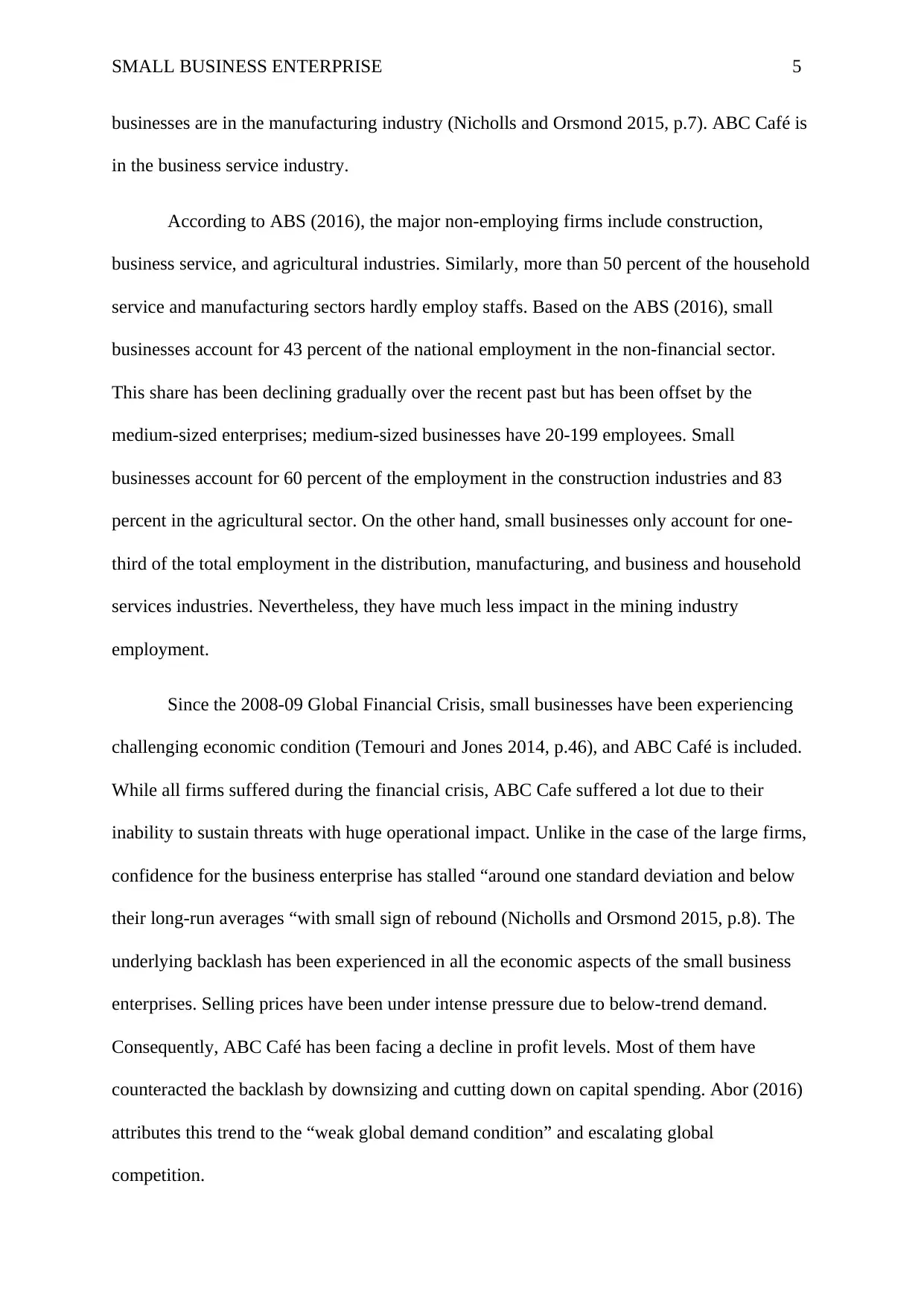
SMALL BUSINESS ENTERPRISE 5
businesses are in the manufacturing industry (Nicholls and Orsmond 2015, p.7). ABC Café is
in the business service industry.
According to ABS (2016), the major non-employing firms include construction,
business service, and agricultural industries. Similarly, more than 50 percent of the household
service and manufacturing sectors hardly employ staffs. Based on the ABS (2016), small
businesses account for 43 percent of the national employment in the non-financial sector.
This share has been declining gradually over the recent past but has been offset by the
medium-sized enterprises; medium-sized businesses have 20-199 employees. Small
businesses account for 60 percent of the employment in the construction industries and 83
percent in the agricultural sector. On the other hand, small businesses only account for one-
third of the total employment in the distribution, manufacturing, and business and household
services industries. Nevertheless, they have much less impact in the mining industry
employment.
Since the 2008-09 Global Financial Crisis, small businesses have been experiencing
challenging economic condition (Temouri and Jones 2014, p.46), and ABC Café is included.
While all firms suffered during the financial crisis, ABC Cafe suffered a lot due to their
inability to sustain threats with huge operational impact. Unlike in the case of the large firms,
confidence for the business enterprise has stalled “around one standard deviation and below
their long-run averages “with small sign of rebound (Nicholls and Orsmond 2015, p.8). The
underlying backlash has been experienced in all the economic aspects of the small business
enterprises. Selling prices have been under intense pressure due to below-trend demand.
Consequently, ABC Café has been facing a decline in profit levels. Most of them have
counteracted the backlash by downsizing and cutting down on capital spending. Abor (2016)
attributes this trend to the “weak global demand condition” and escalating global
competition.
businesses are in the manufacturing industry (Nicholls and Orsmond 2015, p.7). ABC Café is
in the business service industry.
According to ABS (2016), the major non-employing firms include construction,
business service, and agricultural industries. Similarly, more than 50 percent of the household
service and manufacturing sectors hardly employ staffs. Based on the ABS (2016), small
businesses account for 43 percent of the national employment in the non-financial sector.
This share has been declining gradually over the recent past but has been offset by the
medium-sized enterprises; medium-sized businesses have 20-199 employees. Small
businesses account for 60 percent of the employment in the construction industries and 83
percent in the agricultural sector. On the other hand, small businesses only account for one-
third of the total employment in the distribution, manufacturing, and business and household
services industries. Nevertheless, they have much less impact in the mining industry
employment.
Since the 2008-09 Global Financial Crisis, small businesses have been experiencing
challenging economic condition (Temouri and Jones 2014, p.46), and ABC Café is included.
While all firms suffered during the financial crisis, ABC Cafe suffered a lot due to their
inability to sustain threats with huge operational impact. Unlike in the case of the large firms,
confidence for the business enterprise has stalled “around one standard deviation and below
their long-run averages “with small sign of rebound (Nicholls and Orsmond 2015, p.8). The
underlying backlash has been experienced in all the economic aspects of the small business
enterprises. Selling prices have been under intense pressure due to below-trend demand.
Consequently, ABC Café has been facing a decline in profit levels. Most of them have
counteracted the backlash by downsizing and cutting down on capital spending. Abor (2016)
attributes this trend to the “weak global demand condition” and escalating global
competition.
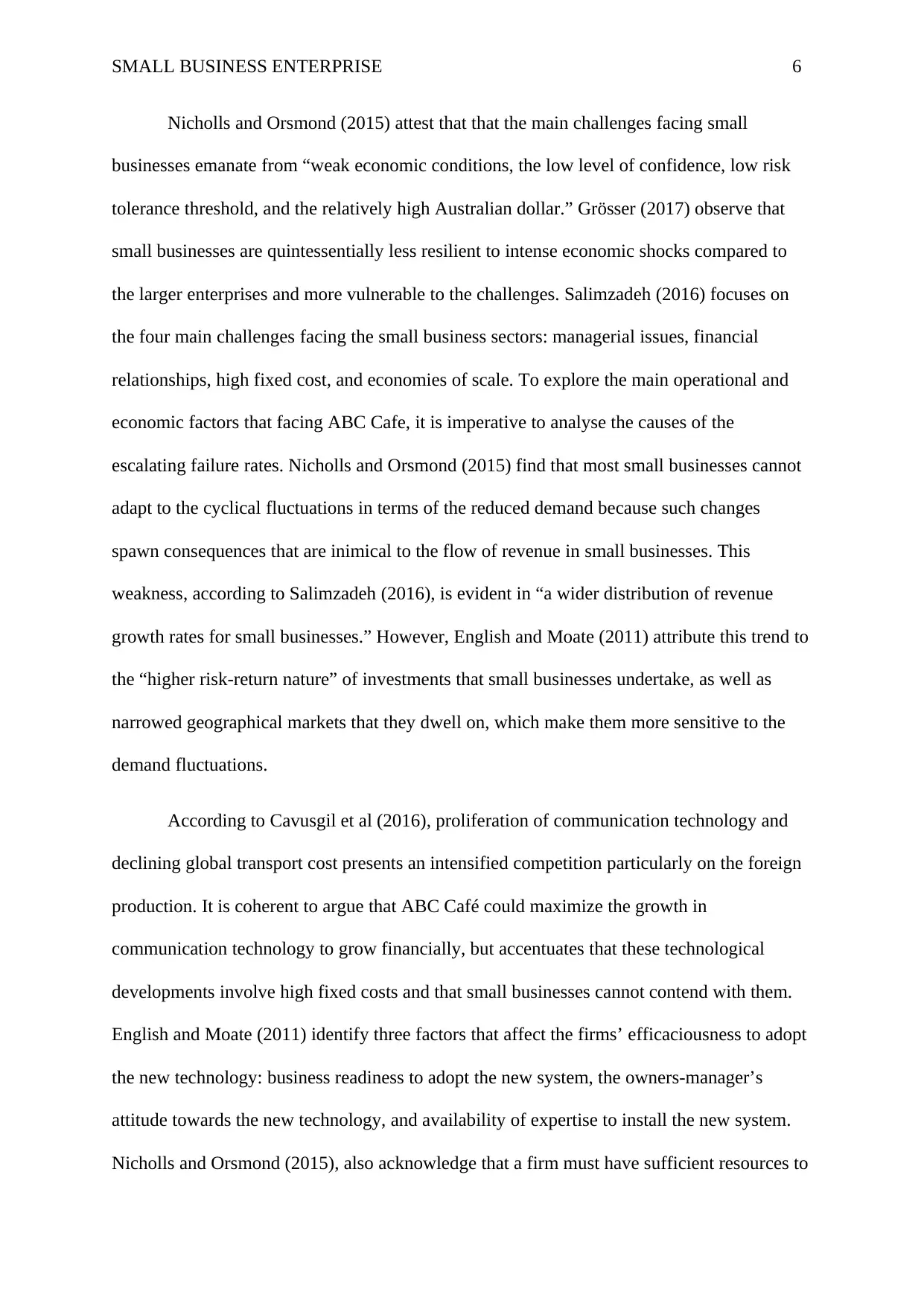
SMALL BUSINESS ENTERPRISE 6
Nicholls and Orsmond (2015) attest that that the main challenges facing small
businesses emanate from “weak economic conditions, the low level of confidence, low risk
tolerance threshold, and the relatively high Australian dollar.” Grösser (2017) observe that
small businesses are quintessentially less resilient to intense economic shocks compared to
the larger enterprises and more vulnerable to the challenges. Salimzadeh (2016) focuses on
the four main challenges facing the small business sectors: managerial issues, financial
relationships, high fixed cost, and economies of scale. To explore the main operational and
economic factors that facing ABC Cafe, it is imperative to analyse the causes of the
escalating failure rates. Nicholls and Orsmond (2015) find that most small businesses cannot
adapt to the cyclical fluctuations in terms of the reduced demand because such changes
spawn consequences that are inimical to the flow of revenue in small businesses. This
weakness, according to Salimzadeh (2016), is evident in “a wider distribution of revenue
growth rates for small businesses.” However, English and Moate (2011) attribute this trend to
the “higher risk-return nature” of investments that small businesses undertake, as well as
narrowed geographical markets that they dwell on, which make them more sensitive to the
demand fluctuations.
According to Cavusgil et al (2016), proliferation of communication technology and
declining global transport cost presents an intensified competition particularly on the foreign
production. It is coherent to argue that ABC Café could maximize the growth in
communication technology to grow financially, but accentuates that these technological
developments involve high fixed costs and that small businesses cannot contend with them.
English and Moate (2011) identify three factors that affect the firms’ efficaciousness to adopt
the new technology: business readiness to adopt the new system, the owners-manager’s
attitude towards the new technology, and availability of expertise to install the new system.
Nicholls and Orsmond (2015), also acknowledge that a firm must have sufficient resources to
Nicholls and Orsmond (2015) attest that that the main challenges facing small
businesses emanate from “weak economic conditions, the low level of confidence, low risk
tolerance threshold, and the relatively high Australian dollar.” Grösser (2017) observe that
small businesses are quintessentially less resilient to intense economic shocks compared to
the larger enterprises and more vulnerable to the challenges. Salimzadeh (2016) focuses on
the four main challenges facing the small business sectors: managerial issues, financial
relationships, high fixed cost, and economies of scale. To explore the main operational and
economic factors that facing ABC Cafe, it is imperative to analyse the causes of the
escalating failure rates. Nicholls and Orsmond (2015) find that most small businesses cannot
adapt to the cyclical fluctuations in terms of the reduced demand because such changes
spawn consequences that are inimical to the flow of revenue in small businesses. This
weakness, according to Salimzadeh (2016), is evident in “a wider distribution of revenue
growth rates for small businesses.” However, English and Moate (2011) attribute this trend to
the “higher risk-return nature” of investments that small businesses undertake, as well as
narrowed geographical markets that they dwell on, which make them more sensitive to the
demand fluctuations.
According to Cavusgil et al (2016), proliferation of communication technology and
declining global transport cost presents an intensified competition particularly on the foreign
production. It is coherent to argue that ABC Café could maximize the growth in
communication technology to grow financially, but accentuates that these technological
developments involve high fixed costs and that small businesses cannot contend with them.
English and Moate (2011) identify three factors that affect the firms’ efficaciousness to adopt
the new technology: business readiness to adopt the new system, the owners-manager’s
attitude towards the new technology, and availability of expertise to install the new system.
Nicholls and Orsmond (2015), also acknowledge that a firm must have sufficient resources to
⊘ This is a preview!⊘
Do you want full access?
Subscribe today to unlock all pages.

Trusted by 1+ million students worldwide
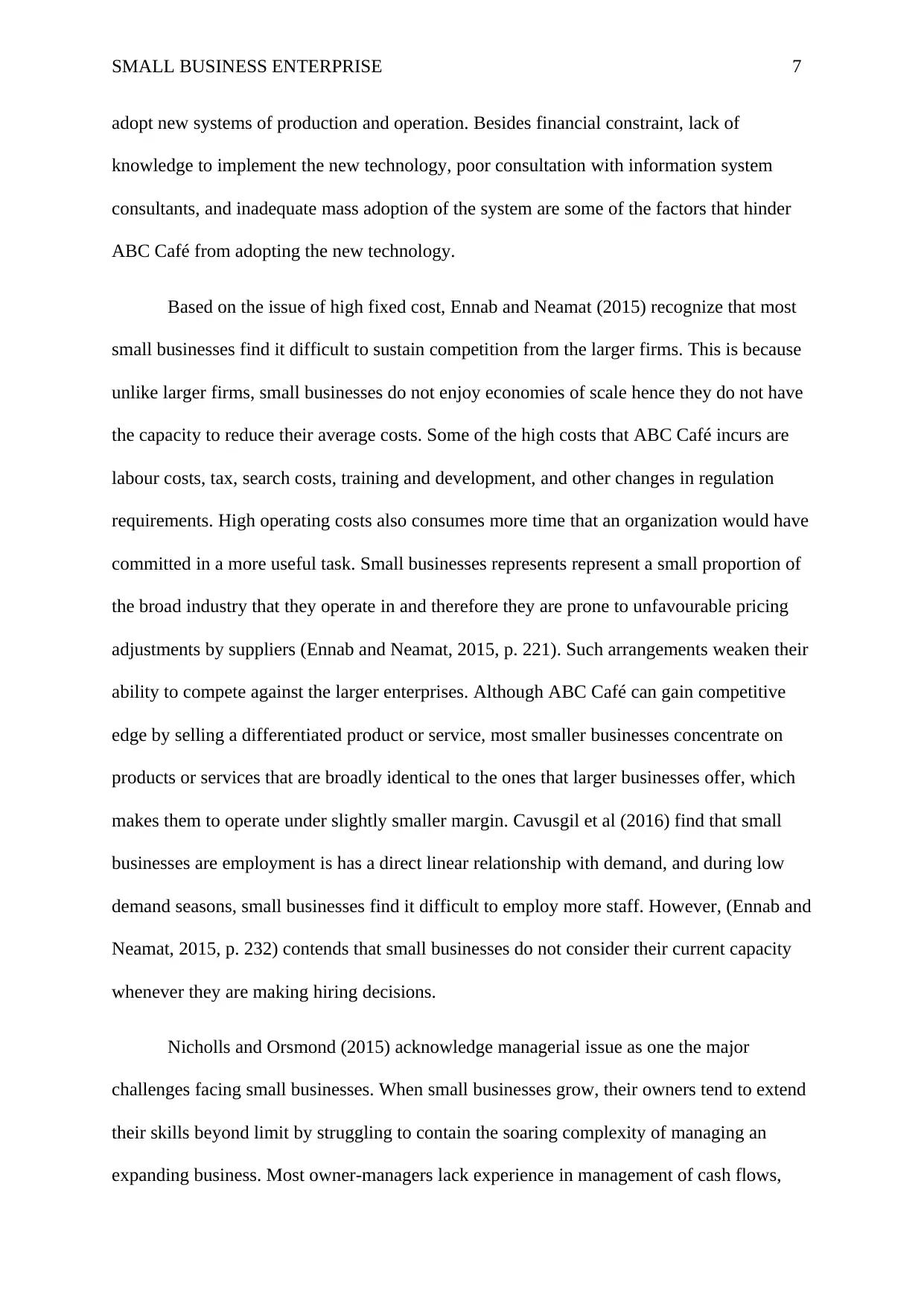
SMALL BUSINESS ENTERPRISE 7
adopt new systems of production and operation. Besides financial constraint, lack of
knowledge to implement the new technology, poor consultation with information system
consultants, and inadequate mass adoption of the system are some of the factors that hinder
ABC Café from adopting the new technology.
Based on the issue of high fixed cost, Ennab and Neamat (2015) recognize that most
small businesses find it difficult to sustain competition from the larger firms. This is because
unlike larger firms, small businesses do not enjoy economies of scale hence they do not have
the capacity to reduce their average costs. Some of the high costs that ABC Café incurs are
labour costs, tax, search costs, training and development, and other changes in regulation
requirements. High operating costs also consumes more time that an organization would have
committed in a more useful task. Small businesses represents represent a small proportion of
the broad industry that they operate in and therefore they are prone to unfavourable pricing
adjustments by suppliers (Ennab and Neamat, 2015, p. 221). Such arrangements weaken their
ability to compete against the larger enterprises. Although ABC Café can gain competitive
edge by selling a differentiated product or service, most smaller businesses concentrate on
products or services that are broadly identical to the ones that larger businesses offer, which
makes them to operate under slightly smaller margin. Cavusgil et al (2016) find that small
businesses are employment is has a direct linear relationship with demand, and during low
demand seasons, small businesses find it difficult to employ more staff. However, (Ennab and
Neamat, 2015, p. 232) contends that small businesses do not consider their current capacity
whenever they are making hiring decisions.
Nicholls and Orsmond (2015) acknowledge managerial issue as one the major
challenges facing small businesses. When small businesses grow, their owners tend to extend
their skills beyond limit by struggling to contain the soaring complexity of managing an
expanding business. Most owner-managers lack experience in management of cash flows,
adopt new systems of production and operation. Besides financial constraint, lack of
knowledge to implement the new technology, poor consultation with information system
consultants, and inadequate mass adoption of the system are some of the factors that hinder
ABC Café from adopting the new technology.
Based on the issue of high fixed cost, Ennab and Neamat (2015) recognize that most
small businesses find it difficult to sustain competition from the larger firms. This is because
unlike larger firms, small businesses do not enjoy economies of scale hence they do not have
the capacity to reduce their average costs. Some of the high costs that ABC Café incurs are
labour costs, tax, search costs, training and development, and other changes in regulation
requirements. High operating costs also consumes more time that an organization would have
committed in a more useful task. Small businesses represents represent a small proportion of
the broad industry that they operate in and therefore they are prone to unfavourable pricing
adjustments by suppliers (Ennab and Neamat, 2015, p. 221). Such arrangements weaken their
ability to compete against the larger enterprises. Although ABC Café can gain competitive
edge by selling a differentiated product or service, most smaller businesses concentrate on
products or services that are broadly identical to the ones that larger businesses offer, which
makes them to operate under slightly smaller margin. Cavusgil et al (2016) find that small
businesses are employment is has a direct linear relationship with demand, and during low
demand seasons, small businesses find it difficult to employ more staff. However, (Ennab and
Neamat, 2015, p. 232) contends that small businesses do not consider their current capacity
whenever they are making hiring decisions.
Nicholls and Orsmond (2015) acknowledge managerial issue as one the major
challenges facing small businesses. When small businesses grow, their owners tend to extend
their skills beyond limit by struggling to contain the soaring complexity of managing an
expanding business. Most owner-managers lack experience in management of cash flows,
Paraphrase This Document
Need a fresh take? Get an instant paraphrase of this document with our AI Paraphraser
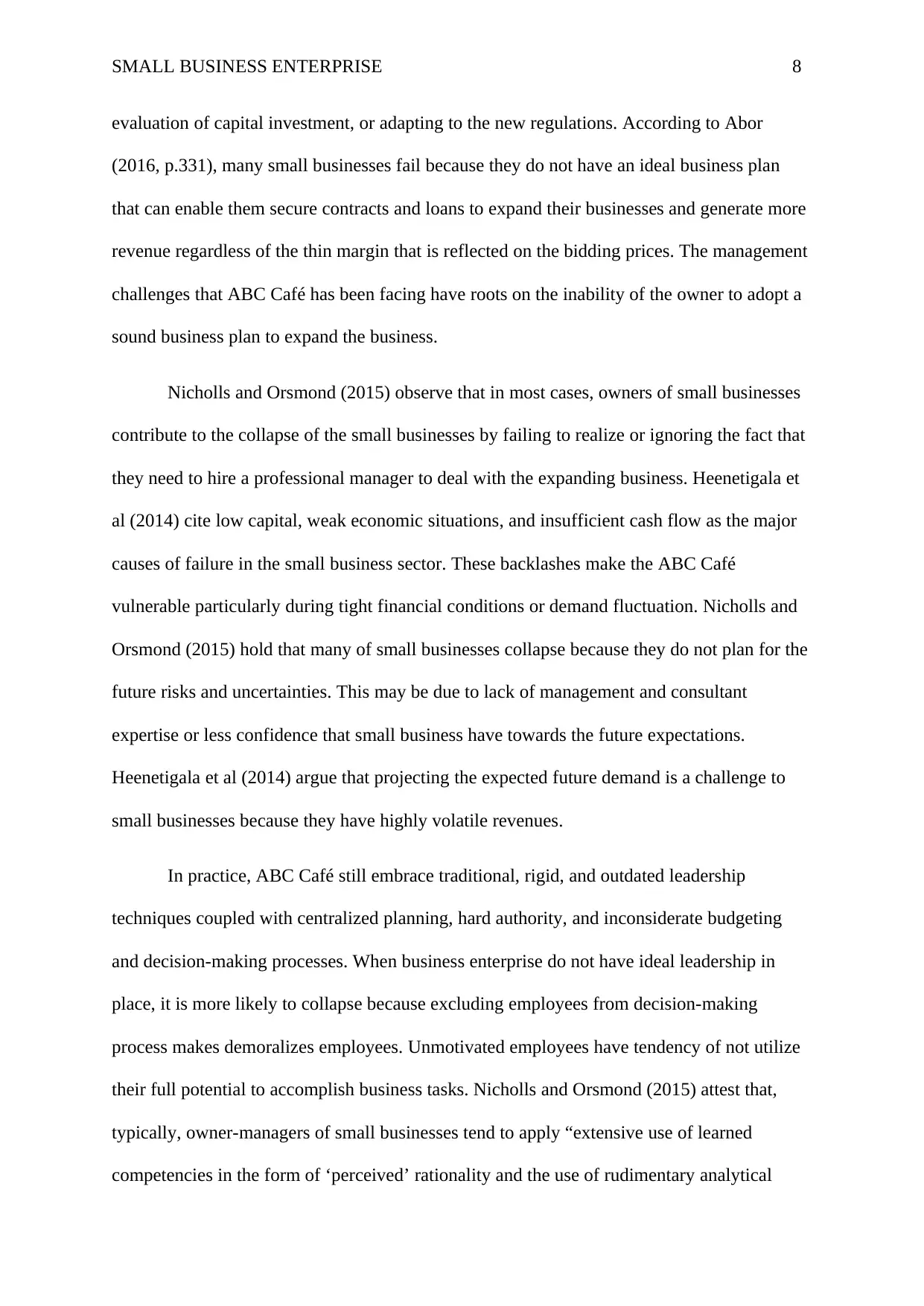
SMALL BUSINESS ENTERPRISE 8
evaluation of capital investment, or adapting to the new regulations. According to Abor
(2016, p.331), many small businesses fail because they do not have an ideal business plan
that can enable them secure contracts and loans to expand their businesses and generate more
revenue regardless of the thin margin that is reflected on the bidding prices. The management
challenges that ABC Café has been facing have roots on the inability of the owner to adopt a
sound business plan to expand the business.
Nicholls and Orsmond (2015) observe that in most cases, owners of small businesses
contribute to the collapse of the small businesses by failing to realize or ignoring the fact that
they need to hire a professional manager to deal with the expanding business. Heenetigala et
al (2014) cite low capital, weak economic situations, and insufficient cash flow as the major
causes of failure in the small business sector. These backlashes make the ABC Café
vulnerable particularly during tight financial conditions or demand fluctuation. Nicholls and
Orsmond (2015) hold that many of small businesses collapse because they do not plan for the
future risks and uncertainties. This may be due to lack of management and consultant
expertise or less confidence that small business have towards the future expectations.
Heenetigala et al (2014) argue that projecting the expected future demand is a challenge to
small businesses because they have highly volatile revenues.
In practice, ABC Café still embrace traditional, rigid, and outdated leadership
techniques coupled with centralized planning, hard authority, and inconsiderate budgeting
and decision-making processes. When business enterprise do not have ideal leadership in
place, it is more likely to collapse because excluding employees from decision-making
process makes demoralizes employees. Unmotivated employees have tendency of not utilize
their full potential to accomplish business tasks. Nicholls and Orsmond (2015) attest that,
typically, owner-managers of small businesses tend to apply “extensive use of learned
competencies in the form of ‘perceived’ rationality and the use of rudimentary analytical
evaluation of capital investment, or adapting to the new regulations. According to Abor
(2016, p.331), many small businesses fail because they do not have an ideal business plan
that can enable them secure contracts and loans to expand their businesses and generate more
revenue regardless of the thin margin that is reflected on the bidding prices. The management
challenges that ABC Café has been facing have roots on the inability of the owner to adopt a
sound business plan to expand the business.
Nicholls and Orsmond (2015) observe that in most cases, owners of small businesses
contribute to the collapse of the small businesses by failing to realize or ignoring the fact that
they need to hire a professional manager to deal with the expanding business. Heenetigala et
al (2014) cite low capital, weak economic situations, and insufficient cash flow as the major
causes of failure in the small business sector. These backlashes make the ABC Café
vulnerable particularly during tight financial conditions or demand fluctuation. Nicholls and
Orsmond (2015) hold that many of small businesses collapse because they do not plan for the
future risks and uncertainties. This may be due to lack of management and consultant
expertise or less confidence that small business have towards the future expectations.
Heenetigala et al (2014) argue that projecting the expected future demand is a challenge to
small businesses because they have highly volatile revenues.
In practice, ABC Café still embrace traditional, rigid, and outdated leadership
techniques coupled with centralized planning, hard authority, and inconsiderate budgeting
and decision-making processes. When business enterprise do not have ideal leadership in
place, it is more likely to collapse because excluding employees from decision-making
process makes demoralizes employees. Unmotivated employees have tendency of not utilize
their full potential to accomplish business tasks. Nicholls and Orsmond (2015) attest that,
typically, owner-managers of small businesses tend to apply “extensive use of learned
competencies in the form of ‘perceived’ rationality and the use of rudimentary analytical
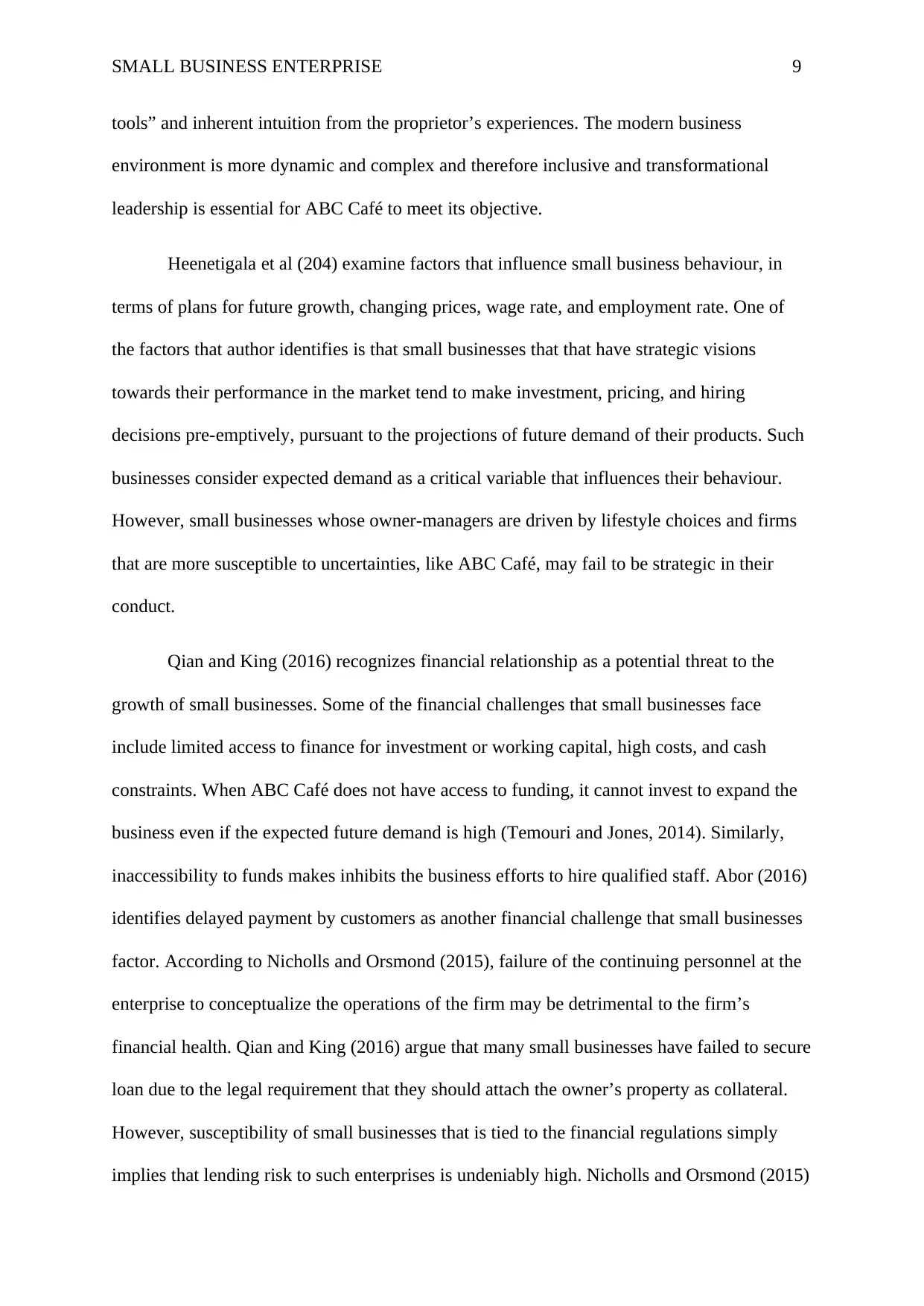
SMALL BUSINESS ENTERPRISE 9
tools” and inherent intuition from the proprietor’s experiences. The modern business
environment is more dynamic and complex and therefore inclusive and transformational
leadership is essential for ABC Café to meet its objective.
Heenetigala et al (204) examine factors that influence small business behaviour, in
terms of plans for future growth, changing prices, wage rate, and employment rate. One of
the factors that author identifies is that small businesses that that have strategic visions
towards their performance in the market tend to make investment, pricing, and hiring
decisions pre-emptively, pursuant to the projections of future demand of their products. Such
businesses consider expected demand as a critical variable that influences their behaviour.
However, small businesses whose owner-managers are driven by lifestyle choices and firms
that are more susceptible to uncertainties, like ABC Café, may fail to be strategic in their
conduct.
Qian and King (2016) recognizes financial relationship as a potential threat to the
growth of small businesses. Some of the financial challenges that small businesses face
include limited access to finance for investment or working capital, high costs, and cash
constraints. When ABC Café does not have access to funding, it cannot invest to expand the
business even if the expected future demand is high (Temouri and Jones, 2014). Similarly,
inaccessibility to funds makes inhibits the business efforts to hire qualified staff. Abor (2016)
identifies delayed payment by customers as another financial challenge that small businesses
factor. According to Nicholls and Orsmond (2015), failure of the continuing personnel at the
enterprise to conceptualize the operations of the firm may be detrimental to the firm’s
financial health. Qian and King (2016) argue that many small businesses have failed to secure
loan due to the legal requirement that they should attach the owner’s property as collateral.
However, susceptibility of small businesses that is tied to the financial regulations simply
implies that lending risk to such enterprises is undeniably high. Nicholls and Orsmond (2015)
tools” and inherent intuition from the proprietor’s experiences. The modern business
environment is more dynamic and complex and therefore inclusive and transformational
leadership is essential for ABC Café to meet its objective.
Heenetigala et al (204) examine factors that influence small business behaviour, in
terms of plans for future growth, changing prices, wage rate, and employment rate. One of
the factors that author identifies is that small businesses that that have strategic visions
towards their performance in the market tend to make investment, pricing, and hiring
decisions pre-emptively, pursuant to the projections of future demand of their products. Such
businesses consider expected demand as a critical variable that influences their behaviour.
However, small businesses whose owner-managers are driven by lifestyle choices and firms
that are more susceptible to uncertainties, like ABC Café, may fail to be strategic in their
conduct.
Qian and King (2016) recognizes financial relationship as a potential threat to the
growth of small businesses. Some of the financial challenges that small businesses face
include limited access to finance for investment or working capital, high costs, and cash
constraints. When ABC Café does not have access to funding, it cannot invest to expand the
business even if the expected future demand is high (Temouri and Jones, 2014). Similarly,
inaccessibility to funds makes inhibits the business efforts to hire qualified staff. Abor (2016)
identifies delayed payment by customers as another financial challenge that small businesses
factor. According to Nicholls and Orsmond (2015), failure of the continuing personnel at the
enterprise to conceptualize the operations of the firm may be detrimental to the firm’s
financial health. Qian and King (2016) argue that many small businesses have failed to secure
loan due to the legal requirement that they should attach the owner’s property as collateral.
However, susceptibility of small businesses that is tied to the financial regulations simply
implies that lending risk to such enterprises is undeniably high. Nicholls and Orsmond (2015)
⊘ This is a preview!⊘
Do you want full access?
Subscribe today to unlock all pages.

Trusted by 1+ million students worldwide
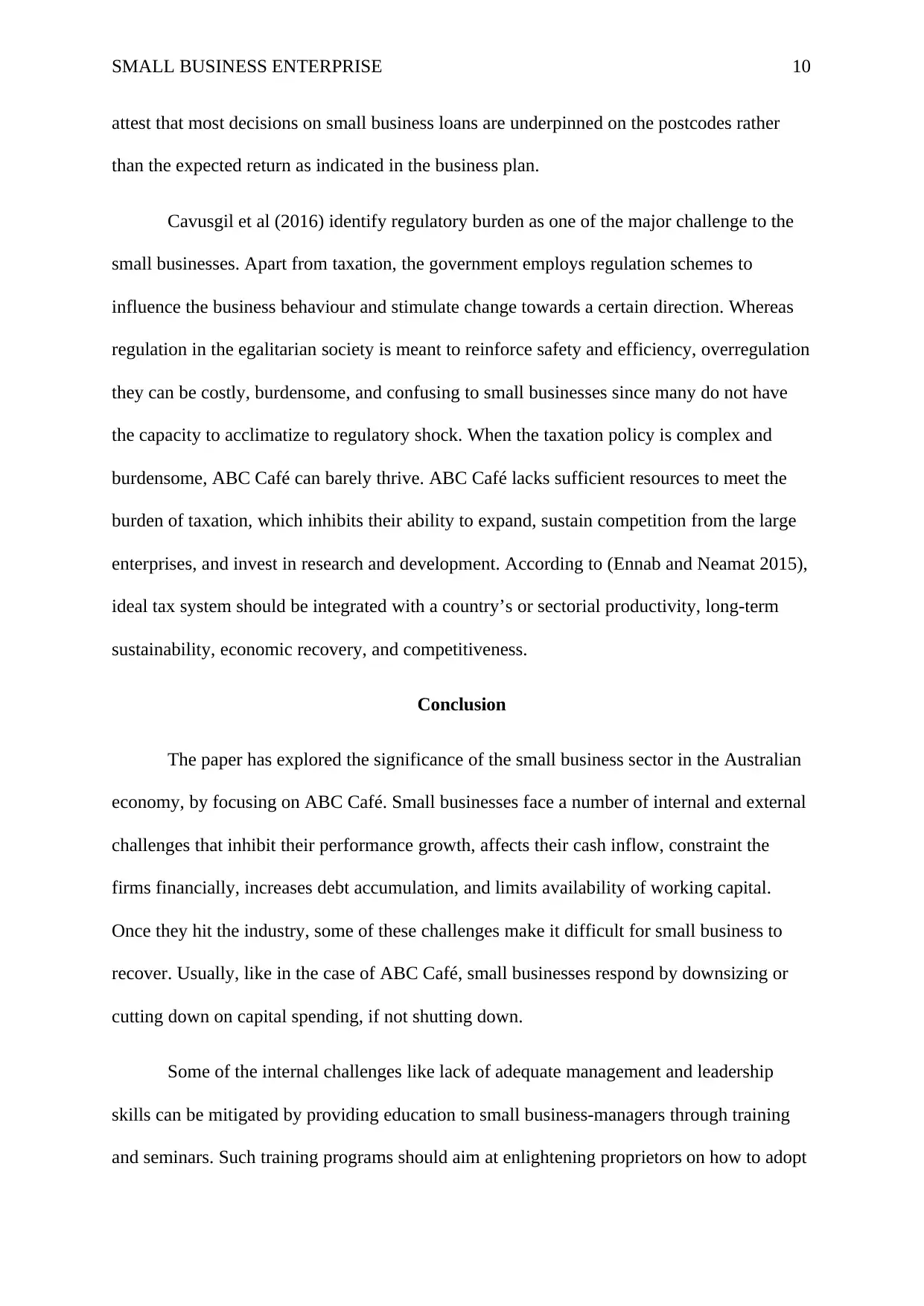
SMALL BUSINESS ENTERPRISE 10
attest that most decisions on small business loans are underpinned on the postcodes rather
than the expected return as indicated in the business plan.
Cavusgil et al (2016) identify regulatory burden as one of the major challenge to the
small businesses. Apart from taxation, the government employs regulation schemes to
influence the business behaviour and stimulate change towards a certain direction. Whereas
regulation in the egalitarian society is meant to reinforce safety and efficiency, overregulation
they can be costly, burdensome, and confusing to small businesses since many do not have
the capacity to acclimatize to regulatory shock. When the taxation policy is complex and
burdensome, ABC Café can barely thrive. ABC Café lacks sufficient resources to meet the
burden of taxation, which inhibits their ability to expand, sustain competition from the large
enterprises, and invest in research and development. According to (Ennab and Neamat 2015),
ideal tax system should be integrated with a country’s or sectorial productivity, long-term
sustainability, economic recovery, and competitiveness.
Conclusion
The paper has explored the significance of the small business sector in the Australian
economy, by focusing on ABC Café. Small businesses face a number of internal and external
challenges that inhibit their performance growth, affects their cash inflow, constraint the
firms financially, increases debt accumulation, and limits availability of working capital.
Once they hit the industry, some of these challenges make it difficult for small business to
recover. Usually, like in the case of ABC Café, small businesses respond by downsizing or
cutting down on capital spending, if not shutting down.
Some of the internal challenges like lack of adequate management and leadership
skills can be mitigated by providing education to small business-managers through training
and seminars. Such training programs should aim at enlightening proprietors on how to adopt
attest that most decisions on small business loans are underpinned on the postcodes rather
than the expected return as indicated in the business plan.
Cavusgil et al (2016) identify regulatory burden as one of the major challenge to the
small businesses. Apart from taxation, the government employs regulation schemes to
influence the business behaviour and stimulate change towards a certain direction. Whereas
regulation in the egalitarian society is meant to reinforce safety and efficiency, overregulation
they can be costly, burdensome, and confusing to small businesses since many do not have
the capacity to acclimatize to regulatory shock. When the taxation policy is complex and
burdensome, ABC Café can barely thrive. ABC Café lacks sufficient resources to meet the
burden of taxation, which inhibits their ability to expand, sustain competition from the large
enterprises, and invest in research and development. According to (Ennab and Neamat 2015),
ideal tax system should be integrated with a country’s or sectorial productivity, long-term
sustainability, economic recovery, and competitiveness.
Conclusion
The paper has explored the significance of the small business sector in the Australian
economy, by focusing on ABC Café. Small businesses face a number of internal and external
challenges that inhibit their performance growth, affects their cash inflow, constraint the
firms financially, increases debt accumulation, and limits availability of working capital.
Once they hit the industry, some of these challenges make it difficult for small business to
recover. Usually, like in the case of ABC Café, small businesses respond by downsizing or
cutting down on capital spending, if not shutting down.
Some of the internal challenges like lack of adequate management and leadership
skills can be mitigated by providing education to small business-managers through training
and seminars. Such training programs should aim at enlightening proprietors on how to adopt
Paraphrase This Document
Need a fresh take? Get an instant paraphrase of this document with our AI Paraphraser
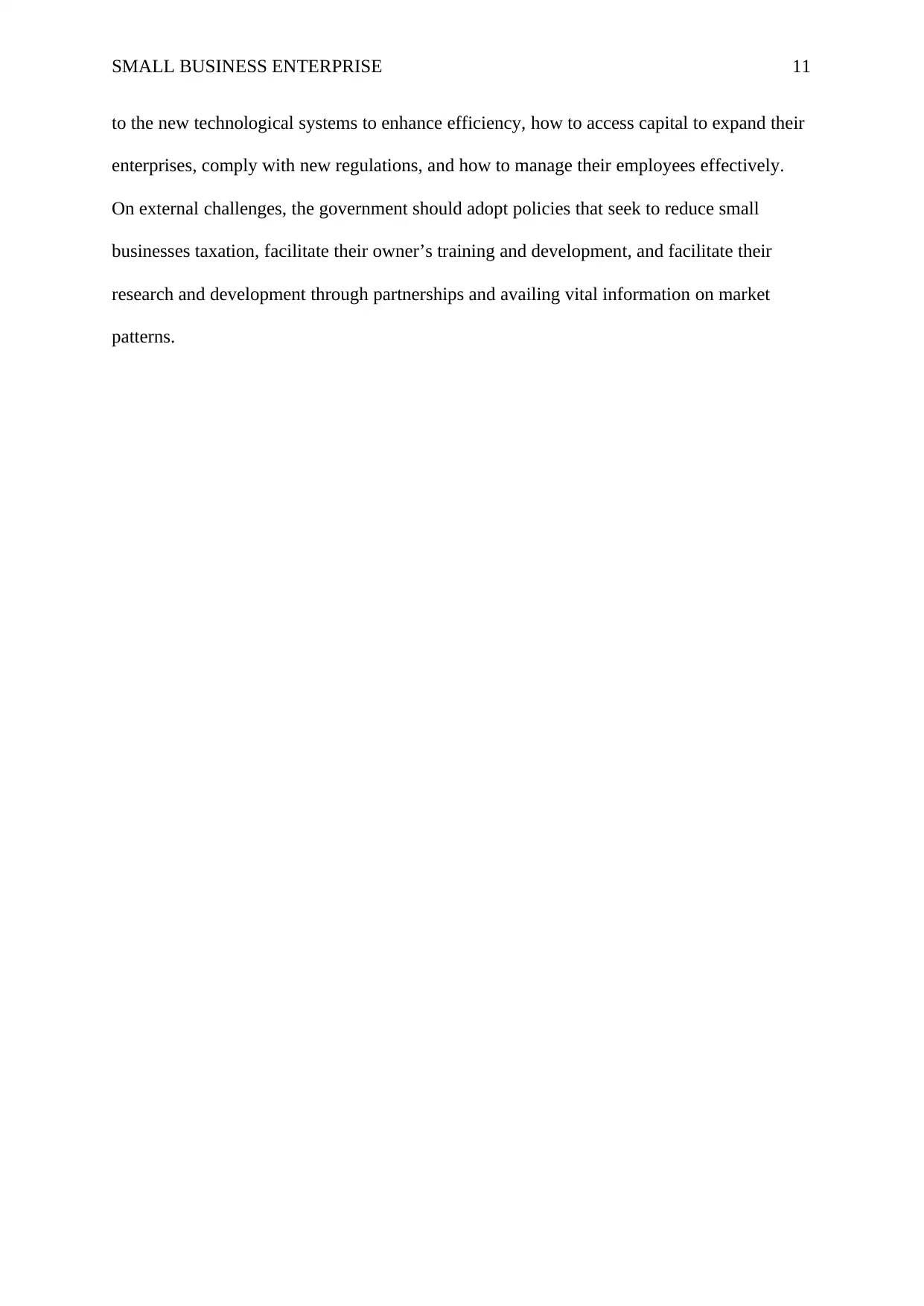
SMALL BUSINESS ENTERPRISE 11
to the new technological systems to enhance efficiency, how to access capital to expand their
enterprises, comply with new regulations, and how to manage their employees effectively.
On external challenges, the government should adopt policies that seek to reduce small
businesses taxation, facilitate their owner’s training and development, and facilitate their
research and development through partnerships and availing vital information on market
patterns.
to the new technological systems to enhance efficiency, how to access capital to expand their
enterprises, comply with new regulations, and how to manage their employees effectively.
On external challenges, the government should adopt policies that seek to reduce small
businesses taxation, facilitate their owner’s training and development, and facilitate their
research and development through partnerships and availing vital information on market
patterns.
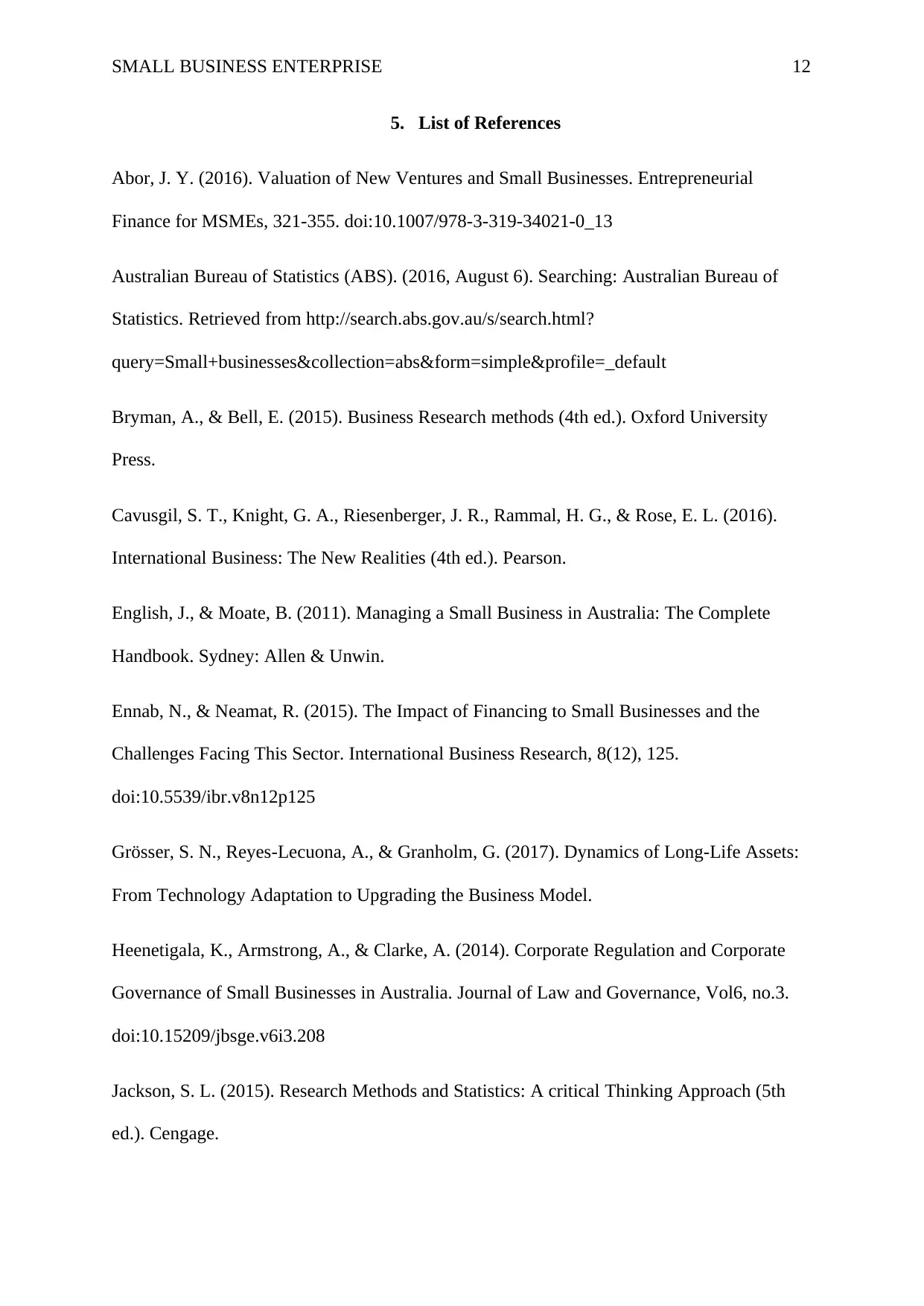
SMALL BUSINESS ENTERPRISE 12
5. List of References
Abor, J. Y. (2016). Valuation of New Ventures and Small Businesses. Entrepreneurial
Finance for MSMEs, 321-355. doi:10.1007/978-3-319-34021-0_13
Australian Bureau of Statistics (ABS). (2016, August 6). Searching: Australian Bureau of
Statistics. Retrieved from http://search.abs.gov.au/s/search.html?
query=Small+businesses&collection=abs&form=simple&profile=_default
Bryman, A., & Bell, E. (2015). Business Research methods (4th ed.). Oxford University
Press.
Cavusgil, S. T., Knight, G. A., Riesenberger, J. R., Rammal, H. G., & Rose, E. L. (2016).
International Business: The New Realities (4th ed.). Pearson.
English, J., & Moate, B. (2011). Managing a Small Business in Australia: The Complete
Handbook. Sydney: Allen & Unwin.
Ennab, N., & Neamat, R. (2015). The Impact of Financing to Small Businesses and the
Challenges Facing This Sector. International Business Research, 8(12), 125.
doi:10.5539/ibr.v8n12p125
Grösser, S. N., Reyes-Lecuona, A., & Granholm, G. (2017). Dynamics of Long-Life Assets:
From Technology Adaptation to Upgrading the Business Model.
Heenetigala, K., Armstrong, A., & Clarke, A. (2014). Corporate Regulation and Corporate
Governance of Small Businesses in Australia. Journal of Law and Governance, Vol6, no.3.
doi:10.15209/jbsge.v6i3.208
Jackson, S. L. (2015). Research Methods and Statistics: A critical Thinking Approach (5th
ed.). Cengage.
5. List of References
Abor, J. Y. (2016). Valuation of New Ventures and Small Businesses. Entrepreneurial
Finance for MSMEs, 321-355. doi:10.1007/978-3-319-34021-0_13
Australian Bureau of Statistics (ABS). (2016, August 6). Searching: Australian Bureau of
Statistics. Retrieved from http://search.abs.gov.au/s/search.html?
query=Small+businesses&collection=abs&form=simple&profile=_default
Bryman, A., & Bell, E. (2015). Business Research methods (4th ed.). Oxford University
Press.
Cavusgil, S. T., Knight, G. A., Riesenberger, J. R., Rammal, H. G., & Rose, E. L. (2016).
International Business: The New Realities (4th ed.). Pearson.
English, J., & Moate, B. (2011). Managing a Small Business in Australia: The Complete
Handbook. Sydney: Allen & Unwin.
Ennab, N., & Neamat, R. (2015). The Impact of Financing to Small Businesses and the
Challenges Facing This Sector. International Business Research, 8(12), 125.
doi:10.5539/ibr.v8n12p125
Grösser, S. N., Reyes-Lecuona, A., & Granholm, G. (2017). Dynamics of Long-Life Assets:
From Technology Adaptation to Upgrading the Business Model.
Heenetigala, K., Armstrong, A., & Clarke, A. (2014). Corporate Regulation and Corporate
Governance of Small Businesses in Australia. Journal of Law and Governance, Vol6, no.3.
doi:10.15209/jbsge.v6i3.208
Jackson, S. L. (2015). Research Methods and Statistics: A critical Thinking Approach (5th
ed.). Cengage.
⊘ This is a preview!⊘
Do you want full access?
Subscribe today to unlock all pages.

Trusted by 1+ million students worldwide
1 out of 13
Related Documents
Your All-in-One AI-Powered Toolkit for Academic Success.
+13062052269
info@desklib.com
Available 24*7 on WhatsApp / Email
![[object Object]](/_next/static/media/star-bottom.7253800d.svg)
Unlock your academic potential
Copyright © 2020–2025 A2Z Services. All Rights Reserved. Developed and managed by ZUCOL.





